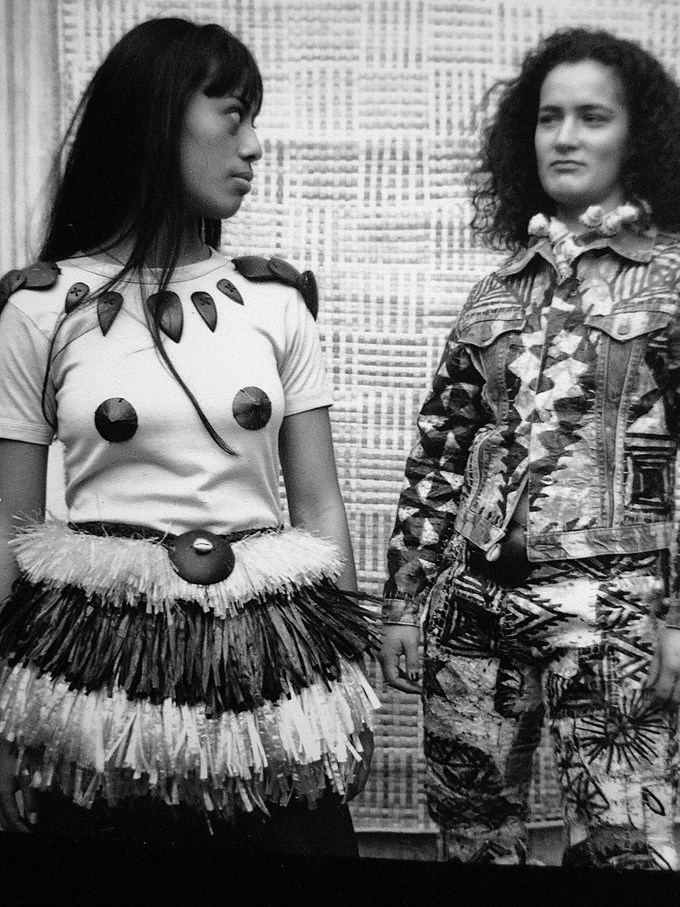In the early ’90s, the Pacific Sisters challenged pre-conceived notions of Pacific perspectives. Born out of dissatisfaction with the white faces and stories dominating Auckland’s narrative, their fashion, dance, music, film and photography expressed complicated issues about being New Zealand-born, mixed-race and different, and their collaborations spun out into shows on the streets that eventually broke into the mainstream and into white-walled galleries.
Now a major retrospective – first shown at Wellington’s Te Papa last year – has found its way to Auckland Art Gallery, in the city where it all began. The exhibition weaves a story of Māori and Pacific creativity, identity and sisterhood and showcases work that smashed stereotypes.
OurAuckland spoke to Rosanna Raymond, a core member of the Pacific Sisters art collective, about identity, creativity and the group’s new retrospective.
OurAuckland: How does it feel coming to Auckland?
Rosanna Raymond: It’s really exciting for us … There are a lot of people here who were directly connected to the Pacific Sisters and actually saw us, were a part of us, bought something off us or danced and partied with us. So we feel like it’s a homecoming. Homecoming queens.
OA What was the art scene like when you formed in the ’90s?
RR You could count the number of [Pacific] artists on one hand. And they were mainly men – Fatu Feu’u, John Pule, Johnny Penisula. So when I first met Ani [O’Neill], it was through a friend of mine who told me about this amazing young artist who had this end-of-year show out of Elam. So I went to that. I always say it’s like a love story; we all kind of fell in love with each other. The Pacific Sisters came as we were bouncing around the clubs and streets, and that’s when the movement was happening, too – Pacific theatre, Pacific art, the writers.
So we were just a piece of the jigsaw puzzle, really.
OA What do you think the Pacific Sisters did for Auckland?
RR It’s really hard to ask us, because we were really flabbergasted. Even when Nina [Tonga] said, ‘I really want to curate this show’, we were looking at her going, ‘Why?’ It’s funny, because we struggled through those times. We weren’t accepted. We weren’t accepted into the art world. But what a lot of the next generation have told us is they see us and all of our antics and go, ‘Oh, wow. That’s me.’ But we definitely changed the cultural landscape as to what people thought of Pacific Island art and culture. We stood up to things we believed in in terms of the tino rangatiratanga movement, the legalise marijuana movement, the queer movement.

OA What has changed since then?
RR There’s just so much more. Back then, there would be four Pacific Island events in a year, now there’s about four a week. And I see that our youth are just so much more confident. But then on the flipside, there are still a lot of the same issues that I see the young artists dealing with. They’re still dealing with identity, being a New Zealand-born Pacific Islander. So all those things are still bubbling away.
OA Which artists are doing cool things in Auckland right now?
RR Oh my God, I have so many that I love. It’s like asking to choose a favourite child. I came back from London because I kept looking through social media and going, ‘Wow, those guys are going off, and they’re having way too much of a good time. I’m coming home. That’s enough.’ I got complete FOMO. A lot of my heroes I work with – Ani, Lisa [Reihana]. And then of course you’ve got the likes of the FAFSWAG collective, who are just next level.
Pacific Sisters: He Toa Tāera | Fashion Activists runs at Auckland Art Gallery from Saturday 23 February to Sunday 14 July.
Interview by Jean Teng


